Words and photos courtesy of KC Shum
Disclaimer: Everything written here is my personal opinion and observation, with no intention against anyone or any community.
I spent many hours taking detailed pictures of both models and writing descriptions for each picture. The official 1:1 R34 V-Spec II brochure from Nissan was used as a reference. Hope you guys enjoy reading this and find this useful. Cheers!
I received many requests from collectors to compare the new release from AUTOart in COMPOSITE form to the old release in DIECAST. Within this comparison here I inspected and observed closely both composite and diecast samples. Each photo and its corresponding description will provide my insights, so far these are the most significant changes or differences I found. If you discover any more, feel free to comment and share with others. From my point of view, the realism and how close it is compared to 1:1 Nur R34 is very important, so criticism and comments from me are based on these simple guidelines.
MY FINAL VERDICT on the composite model:
– All hinges on the car were improved.
– Accurate proportions were executed on the new composite model.
– Panel gapping is better compared to the diecast model.
– Some details were missing on the composite model, but that is not a big deal. Because those details are not that obvious unless you see them closely.
– Hope AUTOart will improve on the paint job. The reflection on the car is not as good as some resin models. I am not sure is it because of the material used, the reflection is dull.
Overall, the model really amazed me. For this price with fully opening features, there is no other manufacturer that currently offers the same. I HIGHLY recommend the composite version to those who would like to collect the Nur R34. When you consider the old release where the price was skyrocketed, this is not a bad purchase.
If you want to learn more about t AUTOart composite models in general and why AUTOart made the transition, feel free to check the link below:
https://diecastsociety.com/autoart-new-composite-model/
1.) Here will be comparing the new release of the Nissan Skyline GTR R34 VSpec II Nur where overall body panels of the car were made with composite compare to the old release where parts of the body were made with diecast metal and plastic.
When AUTOart first announced the change of material of metal they used for years to composite, not many collectors were enthusiastic about the move! Much conversation has been had and many debates since the transition.
After many years of the initial diecast model, AUTOart reissued their Nissan Skyline GTR R34 in composite form. This is my first composite model; the main reason these examples are difficult to find they are extremely rare in metal.
To be honest, when I first unboxed and handled it, it wasn’t as bad as other collectors say, even I was amazed by the quality, assembly and attention to details made by AUTOart.
Below, I will uncover the bad and good, or if you choose the pros and cons of the composite and diecast version of Nissan Skyline GTR R34 V-Spec II Nur.
Weight (Top – Composite | Bottom – Diecast Metal)
2.) First, when AUTOart announced the shift to composite (they will use for the majority of their upcoming model), weight is the very first thing that a lot of collectors were concerned about. There is a difference of only 94 grams between the two. I don’t have any negative feelings when handling the new composite. From AUTOart, the inside for all the interior components like seat, dashboard and etc. are attached is made with diecast metal.
Front (Left – Composite | Right – Diecast Metal)
3.) The proportions of the composite version are more accurate compared to 1:1. The grille area with the GTR logo is slightly taller on the diecast version which is less accurate compared to 1:1. But the crease line on the bonnet of the diecast version is more towards the 1:1 which is more realistic.
Rear (Left – Composite | Right – Diecast Metal)
4.) Proportions for both versions are very accurate in comparison to 1:1. However, the crease line below the 3rd brake light on the trunk of the diecast version is more similar to 1:1, that line shows from the right tail light to the left tail light which is more accurate in my opinion. The composite version is executed better on the panel lines around the tail lights which is more aligned with the 1:1.
Side (Top – Composite | Bottom – Diecast Metal)
5.) The side profile for both versions is very similar, but the diecast example has a more accurate curve in angle on the lower section of the front bumper, the angle on the composite model is slightly exaggerated.
Headlights & Turn Signal (Top – Composite | Bottom – Diecast Metal)
6.) AUTOart did a pretty good job on both headlights but the composite version got better details. And obviously, the turn signal on the composite is much better and more realistic compared to the diecast version.
Bonnet (Top – Composite | Bottom – Diecast Metal)
7.) AUTOart finishes the underside bonnet of the composite version with carbon fibre texture and better details which is similar to 1:1 and compared to the diecast version where they finished it with the same body colour and with the grey section as a heat insulation pad. The new release came with a hood strut bar and not included in the diecast version. (The one you see here is custom made by me)
Engine (Top – Composite | Bottom – Diecast Metal)
8.) Overall details, composite is better where it is more accurate and similar with 1:1. The Iconic wording ‘RB26’ where it should be on the engine is missing on the diecast version. But the 2 lines on the engine cover where it should be there are missing on the composite version.
Hood hinges (Top – Composite | Bottom – Diecast Metal)
9.) The hinges on the composite version are miles better compared to the Diecast version, it is more realistic and similar to 1:1.
Grille (Top – Composite | Bottom – Diecast Metal)
10.) The mesh style used on the composite version is more accurate and similar to 1:1. The grille on both versions got actual holes and not a piece of plastic. However, the intake below the turn signal, both models came with a piece of plastic and don’t have any holes.
Panel gaps (Top – Composite | Bottom – Diecast Metal)
11.) As mentioned by AUTOart the new material is easy to mould the parts with sharper edges, cleaner gaps to make the model looks more genuine. From the picture, we can see the gapping and edges on the composite is cleaner and sharper when compared to the diecast version.
Bonnet vent (Top – Composite | Bottom – Diecast Metal)
12.) Both versions are finished rather nicely with carbon fibre texture. However, the vents on the diecast version are a separate piece while the vent on the composite version is together with the bonnet. In terms of the details, composite is better, mainly because there is a mesh with holes on the vents and diecast only provides holes without a mesh.
Naming Emblem & Taillight (Top – Composite | Bottom – Diecast Metal)
13.) This is a clear win for the composite version, where they finish it with 3D-like metal that looks like material for the naming compared to the diecast version only printing on the car body. The crease line below the ‘V-Spec II Nur’ wording should be deeper like in the diecast version this is more towards the 1:1. Also, the taillight on the diecast version got a more accurate colour and the size is of the turn signal is similar is 1:1, the turn signal on the composite version is too small compared to 1:1.
Rear Emblem & Trunk keyhole (Top – Composite | Bottom – Diecast Metal)
14.) This is a very obvious result. The Nissan and GTR emblem is 3D-like compared to the diecast version where both emblems were printed on the car body. The trunk keyhole is much better on the composite version, besides the position of the GTR logo is more accurate and similar to 1:1. Once again, the red colour of the 3rd brake light is better on the diecast version.
Reverse & Rear Fog light (Top – Composite | Bottom – Diecast Metal)
15.) The fitment for both lights on the composite version is more inline to 1:1, where it looks cleaner as well in comparison to the diecast version.
Front Emblem (Top – Composite | Bottom – Diecast Metal)
16.) Once again, the emblem on the composite Version is 3D-like and looks similar to 1:1. But the intake on the front lips for brake cooling on the diecast version has actual holes but not for the composite version.
Trunk hinges (Top – Composite | Bottom – Diecast Metal)
17.) The hinges on the composite are better and closer to 1:1 compared to the diecast version.
Colour (Top – Composite | Bottom – Diecast Metal)
18.) From this angle, we can clearly see the colour difference. For the diecast version, only the body, doors and bonnet are made with diecast metal while the front and rear bumper are made with plastic. So over some time, colour differences can be clearly seen. The colour shade on the model will change over time, different materials react differently. I believe this won’t happen to composite as all the panels are made with the same material, even though the colour shade will change over time, but at least it won’t have a significant result.
Trunk Panel Gap (Top – Composite | Bottom – Diecast Metal)
19.) Once again, the panel gap on the composite is better and looks sharper and cleaner compared to the diecast version.
Bumper Panel Gap (Top – Composite | Bottom – Diecast Metal)
20.) The same is true here, composite got a better and cleaner finish.
Spoiler Stand (Top – Composite | Bottom – Diecast Metal)
21.) The wing stand on the composite version is a separated piece while you can see on the diecast version it is one piece construction mounted to the trunk.
Spoiler Stand (Top – Composite | Bottom – Diecast Metal)
22.) Better details on the diecast version which is more accurate to 1:1 when compared to the composite version.
Trunk (Top – Composite | Bottom – Diecast Metal)
23.) Since the tail light on the composite model is the same piece as the body, overall fitment is better. Besides, the material used in the trunk for the composite version feels like soft fabric when you touch it. Quite the opposite with the diecast version, feels like hard satin material.
Defroster Grids (Top – Composite | Bottom – Diecast Metal)
24.) The composite version is simply more accurate in comparison to the 1:1.
Side Emblem & Side Marker (Top – Composite | Bottom – Diecast Metal)
25.) The word ‘GT’ can be clearly seen on the composite version but the side marker looks better on the diecast piece. While the vertical line on the door of the composite version is more accurate with the 1:1.
Rims & Tyre (Top – Composite | Bottom – Diecast Metal)
26.) The paint job on the composite is slightly better. Overall design on the composite version is more accurate in regards to 1:1 and it came with tyre pressure caps as well. The spokes on the diecast version are too thin. But the center cap on the rim of the diecast version is more visible compare to the composite version. For tyres, composite wins, as the tyre branding is shown on the sidewall.
Front Bumper Gap (Top – Composite | Bottom – Diecast Metal)
27.) Once again, the composite version wins, overall, better fitment and looks cleaner.
Door Open Mechanism & Side Windows (Top – Composite | Bottom – Diecast Metal)
28.) This is a clear win for the composite, it looks more realistic and more consistent compared to the diecast version. The composite model came with side windows where windows are not available on the diecast version.
Door Hinge (Top – Composite | Bottom – Diecast Metal)
29.) An obvious win for the composite again, it looks more realistic in comparison to the diecast version.
Floor Mat (Top – Composite | Bottom – Diecast Metal)
30.) Both examples did not come with any floor mats, however, but both models used a fabric-like material for the footrest.
Seats (Top – Composite | Bottom – Diecast Metal)
31.) From the look, the composite version looks better and the design is more in tune with 1:1 but when you touch it, the diecast version feels better because of the material used.
Seat Details (Top – Composite | Bottom – Diecast Metal)
32.) The seat details are slightly better on the diecast version compared to the composite.
Windows Switches (Top – Composite | Bottom – Diecast Metal)
33.) These switches are missing from the original diecast version. The composite version excels, and the additional detailing looks great!
Interior (Top – Composite | Bottom – Diecast Metal)
34.) Both are very detailed but the dashboard on the diecast in my opinion looks like plastic.
Center Console (Top – Composite | Bottom – Diecast Metal)
35.) In terms of details and realism, the composite version is better. The composite model has the additional 120W with a 6-disc head unit, while the diecast version only has the 80W 4-disc head unit.
Interior Light (Top – Composite | Bottom – Diecast Metal)
36.) The diecast version is missing the interior light while the composite version came with it and got better detailing on the switches as well.
Exhaust Tips & Diffuser (Top – Composite | Bottom – Diecast Metal)
37.) Over the years there a lot of people complained about the exhaust tips on the V Spec or V Spec II R34, finally, AUTOart addressed this issue on the latest composite version. The results are much better and more realistic when compared to the diecast version. Besides, the fins on the diffuser, the composite version is similar to the 1:1 which is a bonus.
Underside Of The Car (Top – Composite | Bottom – Diecast Metal)
38.) Both versions did a pretty good job here.
Rear Diffuser (Top – Composite | Bottom – Diecast Metal)
39.) The composite version is finished in carbon fibre texture which in my opinion is more in line with the 1:1. When we compare this to the diecast model it is only a plastic piece.
Rear Lower Arm (Top – Composite | Bottom – Diecast Metal)
40.) The composite version excels with more details than the original diecast version
Container (Top – Composite | Bottom – Diecast Metal)
41.) The containers on the composite version finish with a rough surface that appear to make it look more like metal which is more accurate to the 1:1.










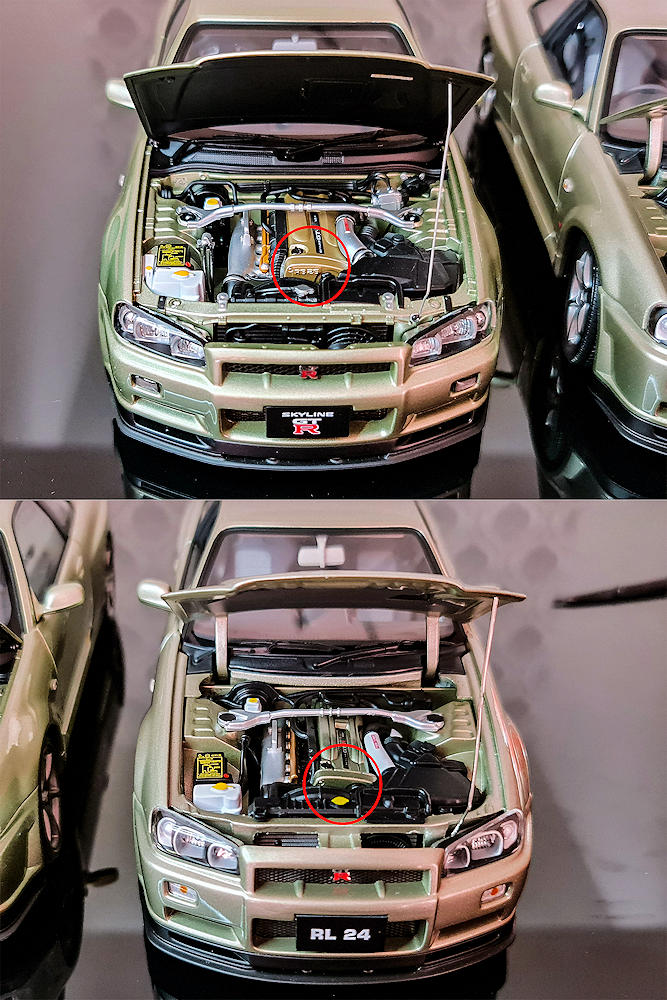



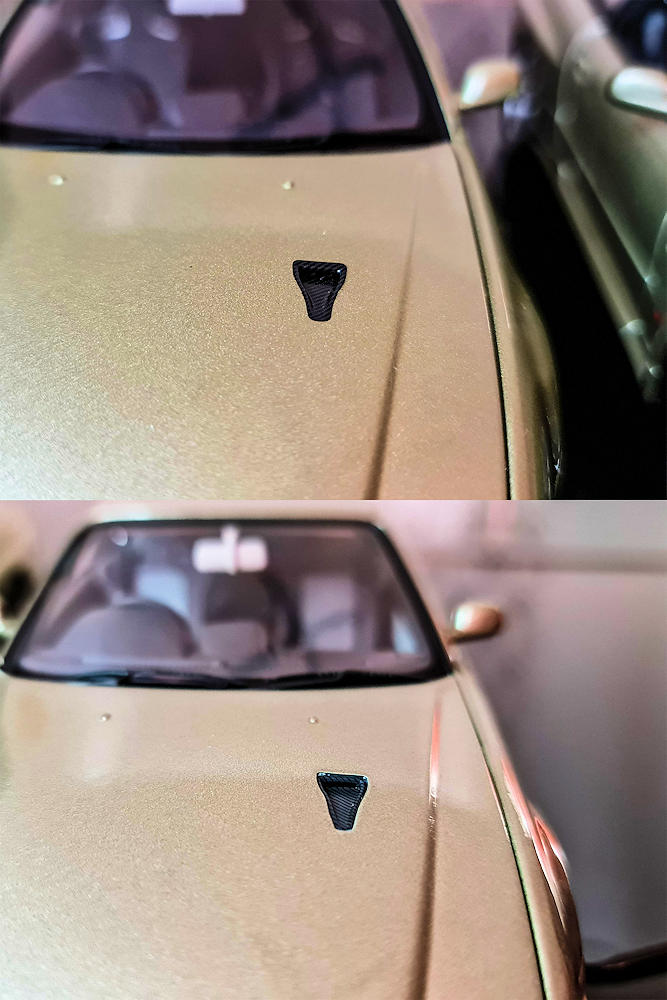
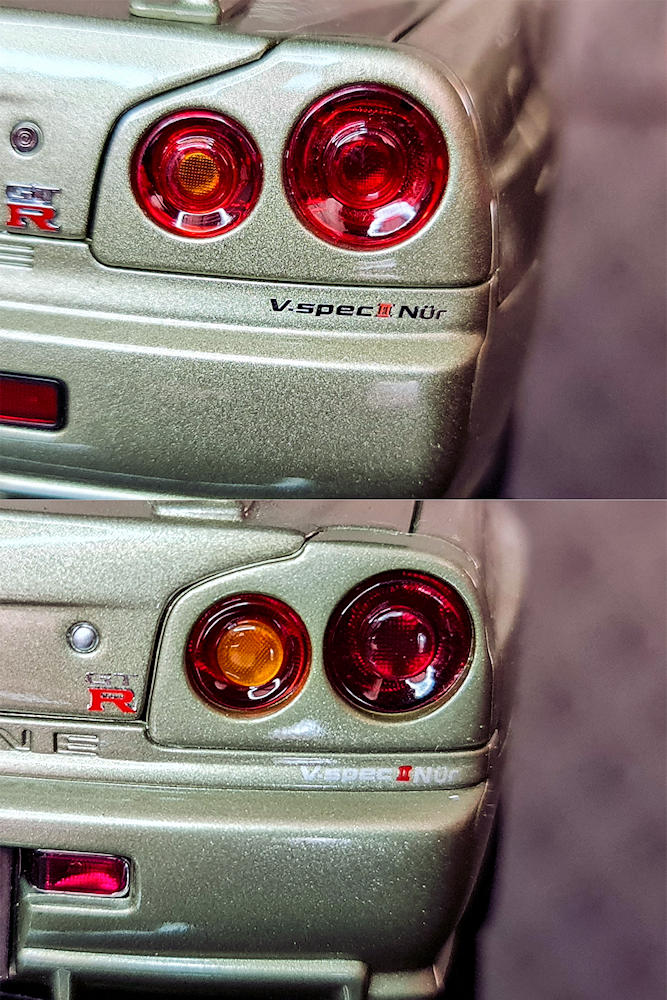













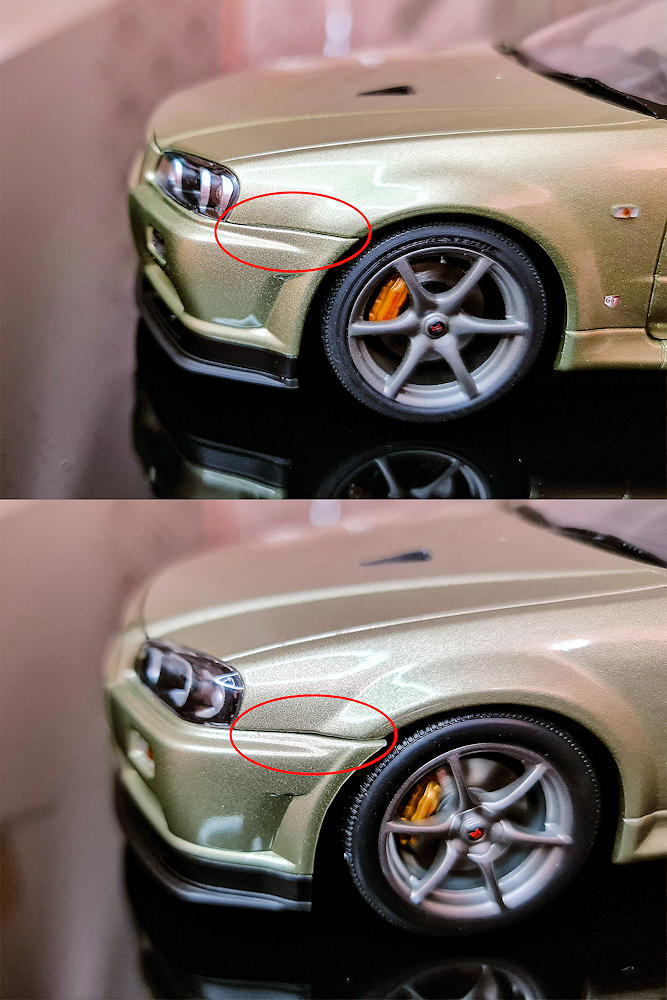










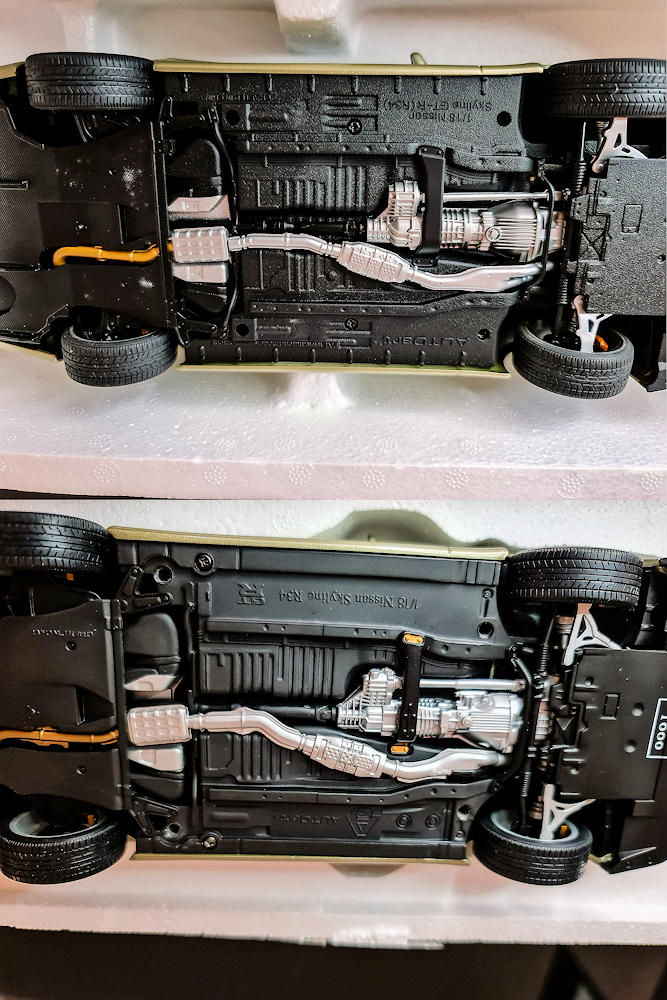


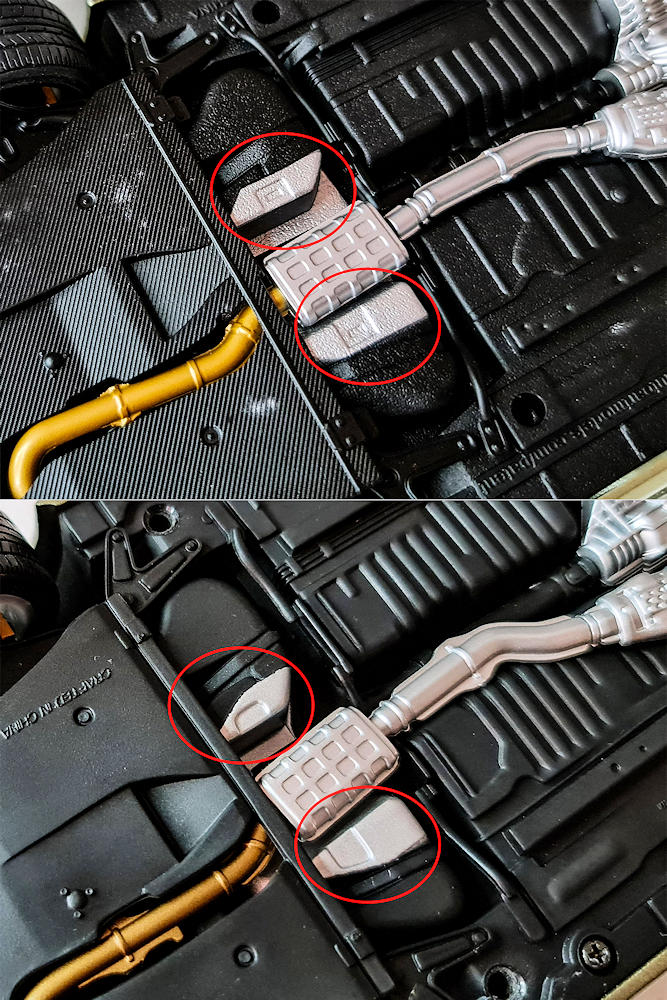
Well done sir. First, we want to commend you for the work it took to complete something of this scale, it’s a lot of work. And second, good on you for taking a chance on composite models from AUTOart. They aren’t all poop. They have some other challenges to manage, but the models are decent overall.
Been waiting for such comparison for a long time, i think when it comes to details and accuracy, it finally debunks the mantra that “Autoart lacks passion” that has been spreading here lately.
Actually i think the very fact that AA is pursuing better gaps and more accurate finish, makes the models look more “clean”, almost “clinical”, and the lack of inaccuracies or rough edges can be perceived like “lack of passion”.
Although, to me Autoart has been lacking “passion” for a long time before they moved on to composite, while their models were spot-on (at least most of them), they just weren’t that exciting. The mustang Mach-1 for example, some cheap AutoWorld variants are looking way more exciting for the paint and detail chooses (details like markings on the tyre sidewalls, some additional striping etc). Lately, with new Camaro and Hellcat releases they at least started going for exciting color choises.
*choices. (Sorry, English is not my native language).
“t finally debunks the mantra that “Autoart lacks passion” that has been spreading here lately”
They still have some work to do. The proof is in the reviews… Passion and execution are two different things. Though we will say the stigma against composite in many cases is unfair.
Excellent post, thank you for your diligence and attention to detail.
Excellently meticulous comparison, very convincing. It´s a pity that this particular model is not my subject matter. It proves that AA CAN actually deliver top notch quality in composite. It´s the more unfortunate, that they don´t always DO, as previous comparisons have shown. I guess, most of the frustration is this inconsistency and that not always doing what they can comes across as deliberate corner-cutting. Prefering the AUTOart over the same model by a competitor used to be a no-brainer 99% of the time (exceptions: Kyosho or AUTOart Lambos were a harder choice), whereas now each new release must be eyed with suspicion, especially when stiffer competition offers alternatives.
There are few exceptions of that, from the top of my head I can remember their Carrera RS 2.7 losing badly in proportion front to Minichamps one.
Great comparison! I’m fairly new to collecting $100+ models and haven’t really handled the AutoArts of old, so this was a cool read.
Thank you for detailed and fair comparison!
I think, in this case of a really old die-cast model with “dog legs” it is clear that a newer composite model with improvements over and there indeed looks better.
However, in case of not so old “signature” die-cast models vs. the newest composite models the situation is rather opposite. (Such as die-cast Pagani Huayra vs composite Pagani Huayra BS).
In case of models that are somewhere in the “middle”, I guess the comparison is quite on a par. For example, a die-cast Porsche Black Bird is quite comparible to a composite Ford Mustang Shelby GT350R in terms of details and everything. But eventually I could not accept the plastic body of the Ford, whereas I’m absolutely happy with the die-cast body of the Porsche model.
Does anyone know when it will become available? It’s not on the Autoart site yet for preorder
Already available in some parts of the world.
Available in the US?
From our understanding, there were delays to the US and Canada stock due to issues with the model. Not sure if any amount were available to either country at this time.
Can you elaborate on the “issues with the model”? Production issues?
No, contact AUTOart for more details.
Great Job with this!!!!! I was the biggest skeptic of Autoart’s composite when they first came out, but it’s clear the composites have gotten much more refined in the past few years. It’s really helpful to see how their newest composites compare to diecast and in this case you made it obvious that the composite easily beats the diecast with this model.
I’d love to see Autoart re-relase an iconic model such as the Mclaren F1 in composite and see a similar in-deptth comparison. If a composite can beat one of their best diecasts than I will be a true convert.
Thanks again for your comparison.
What a wonderful review and comparison and certainly giving scale model car collectors something to think about. Whilst I agree that the new plastic bodied release is a superior model in scale proportions and has added some very nice detailing compared to the diecast, this is only to be expected from the leading premium model car maker in 1/18 scale. Let’s not forget that the original Nissan R34 GT-R was one of the first models released by AUTOart. Even the recently released Solido R34 has a better body shape than the first R34 from AUTOart.
AUTOart has in fact made improvements to all models over time, as can be illustrated in the link below (models are from my own collection):
https://flickr.com/photos/23973738@N03/albums/72157648880436612
Here you can see that the silver earlier release is improved upon by the blue later release and indeed both are comprehensively bettered by the Kyosho R32 and AUTOarts own R33.
I’m not trying to dismiss plastic models, and your pictures look stunning. I have some plastic AUTOart models too and enjoy them to look at. But for me, it’s like the electric car revolution. Impressive, but I’m still old school mechanical.
Thanks for reading.
Good point.
Great post! In my opinion the diecast version Nur would not stand a chance as it’s the very original mod with dog leg door hinge and lacking many details such as side windows. Autoart has since improved the R34 several time with different versions, and the latest diecast Z-Tune has got the same hood hinge as the composite version. Could be a very different result if you compare that one to the upcoming composite Z-Tune I think.
Many thanks for your time and efforts on this one, I appreciate all the pictures and differences. Really helps in decision making!
Great comparison!
Although I must say most of these issues from the diecast version were already addressed and fixed in the later diecast Z-Tune, except the panel gaps of course. Yet on the one I have which also happens to be in Millennium Jade, the gaps are much cleaner compared to the older diecast V-Spec II.
Even though the diecast Z-Tune is already a great model, I’m very excited to see what AA is about to do with the new composite release. The thing I do know is that there might not be a new Z-Tune in Millennium Jade and it makes me a little happy in a selfish matter.
Nice work!
I own one AA composite model, the Toyota 2000GT – I find them to be a no-brainer. It’s lighter, should look better longer (no paint rash), and lines are cleaner and more crisp which leads to a more life-like look overall. Hopefully it’s the ‘wave of the future.’
Great job on the comparo. While I never thought details to suffer when AA introed composite, their trajectory at the time didn’t lead me to believe they would invest in precision manufacturing (a la Bandai), not to mention revising re-releases to take advantage of it. Congratulations to AA for that.
It must have been a heavy investment though because AA’s press release to sell us on composite was that it would lower the costs. I suppose in retrospect, you can say it did… for them. They didn’t say it would be passed on to the consumer.